Abstract
Water budget of pigeons was varied to assess the dependence of risk-sensitive preferences upon economic context such as has been reported for energy-budget manipulations with small animals in behavioral ecology research. Fixed- and variable-interval terminal-link water schedules reinforced choice between equal variable-interval initial-link schedules arranged on two pecking keys. While keeping a severely restrictive budget the same across three phases of the experiment, a contrasting distinct ample budget was arranged in each. To mimic typical methods in behavioral ecology studies, in each ample budget a more than three-fold increase in amount of water per reinforcer presentation was instituted simultaneously with significantly increased overall access to water. Total choice response rates plummeted in the ample budgets, and body weights either increased significantly or remained unchanged in different phases as expected by the nature of the different manipulations. Clear preferences for the variable-interval schedule were found throughout the experiment, except for rare instances of key bias. The results agree with similar operant food-reinforcement studies and extend conditions under which risk preference apparently does not depend upon economic context.
Full text
PDF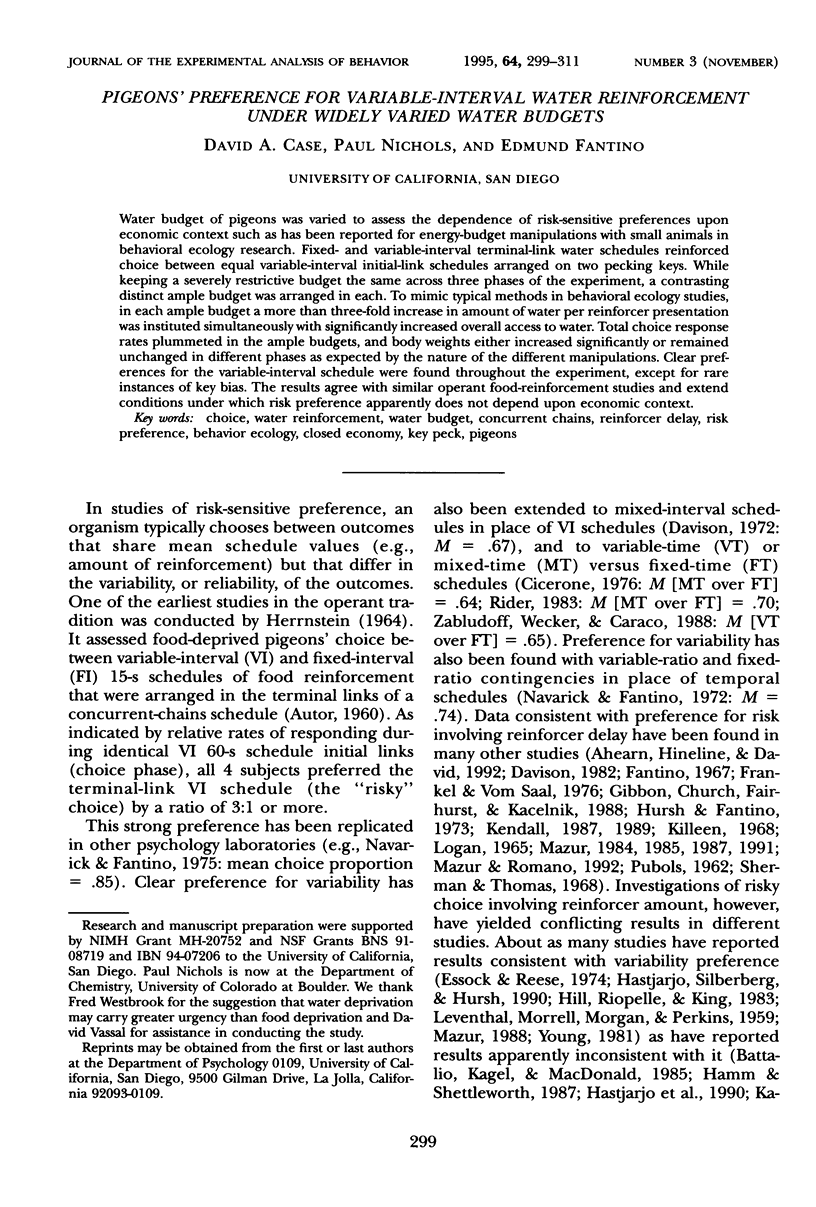
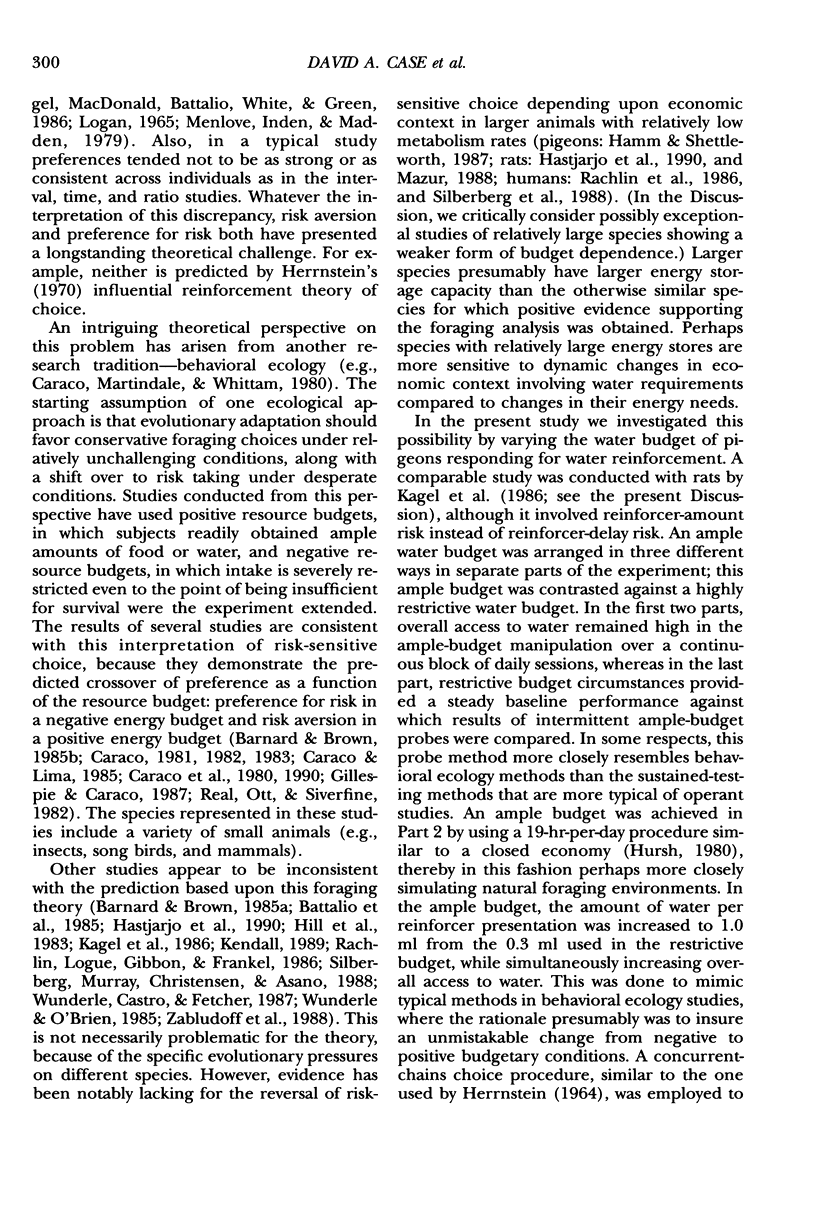


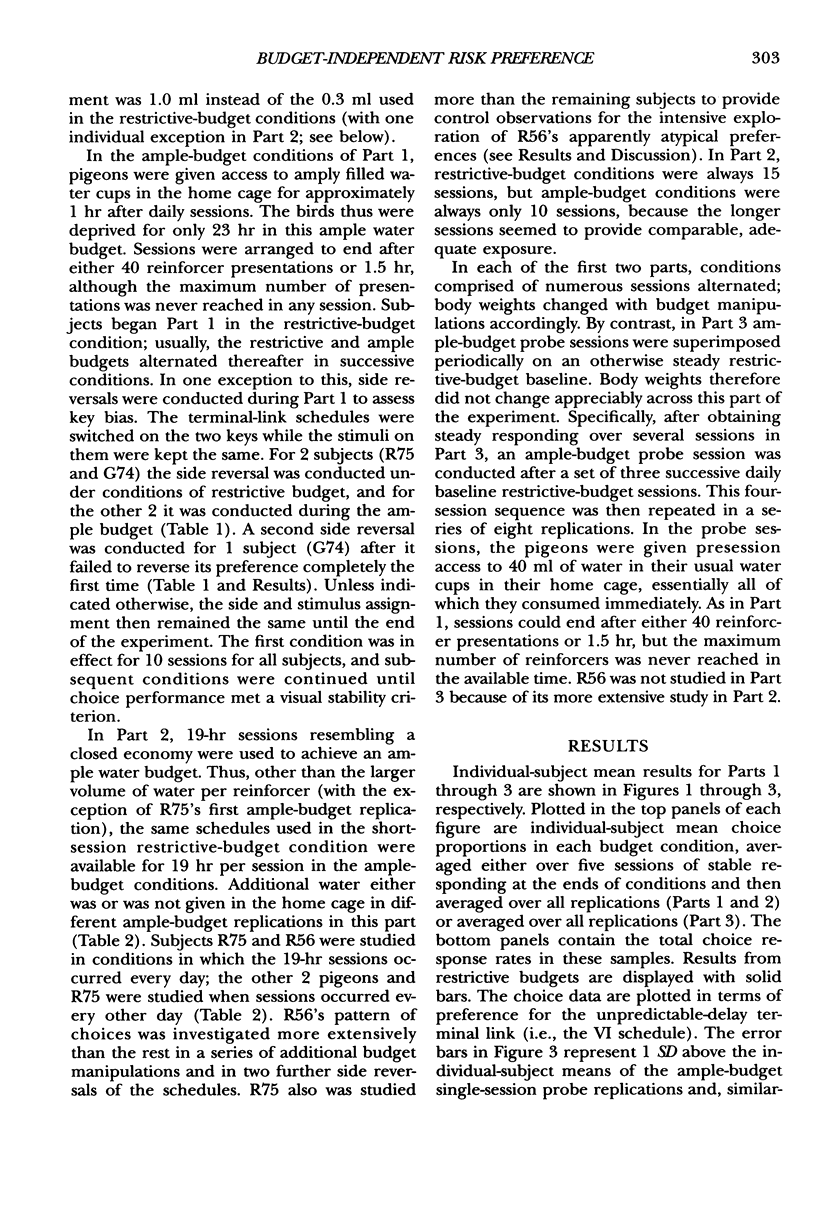
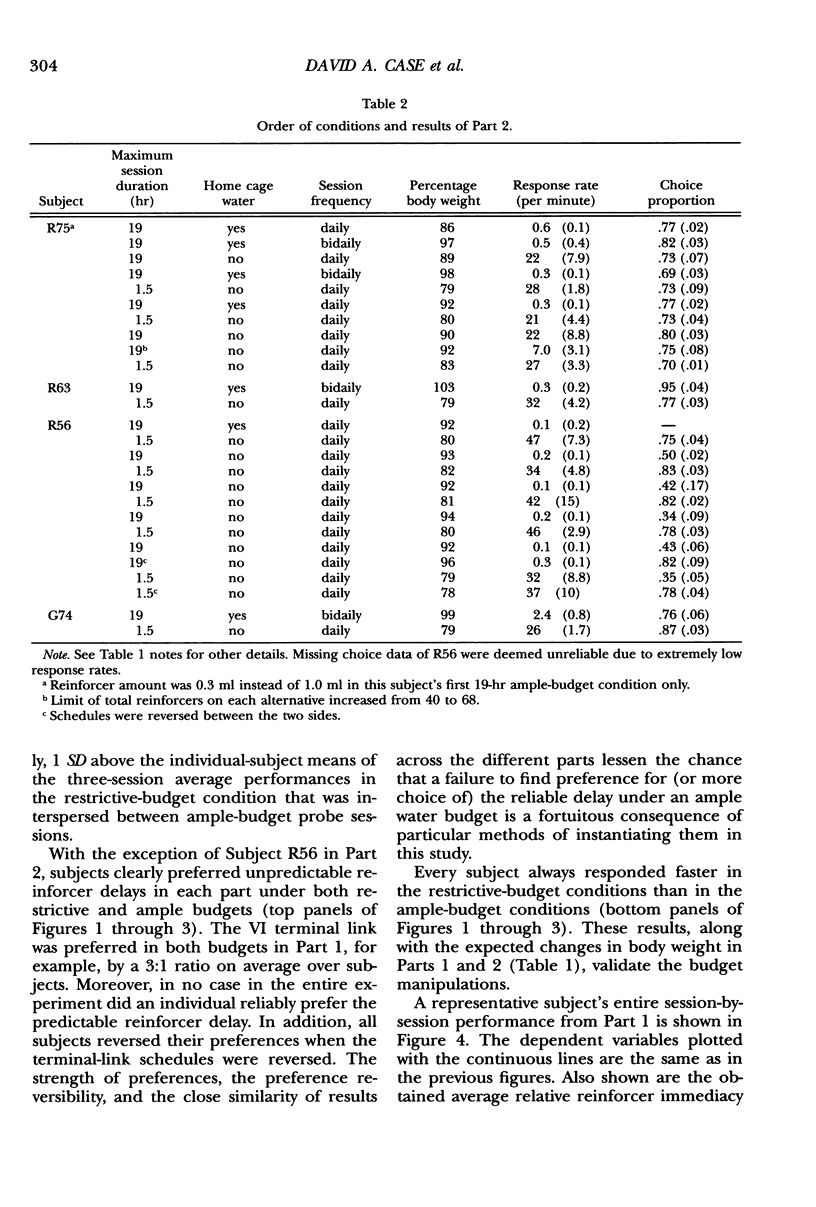
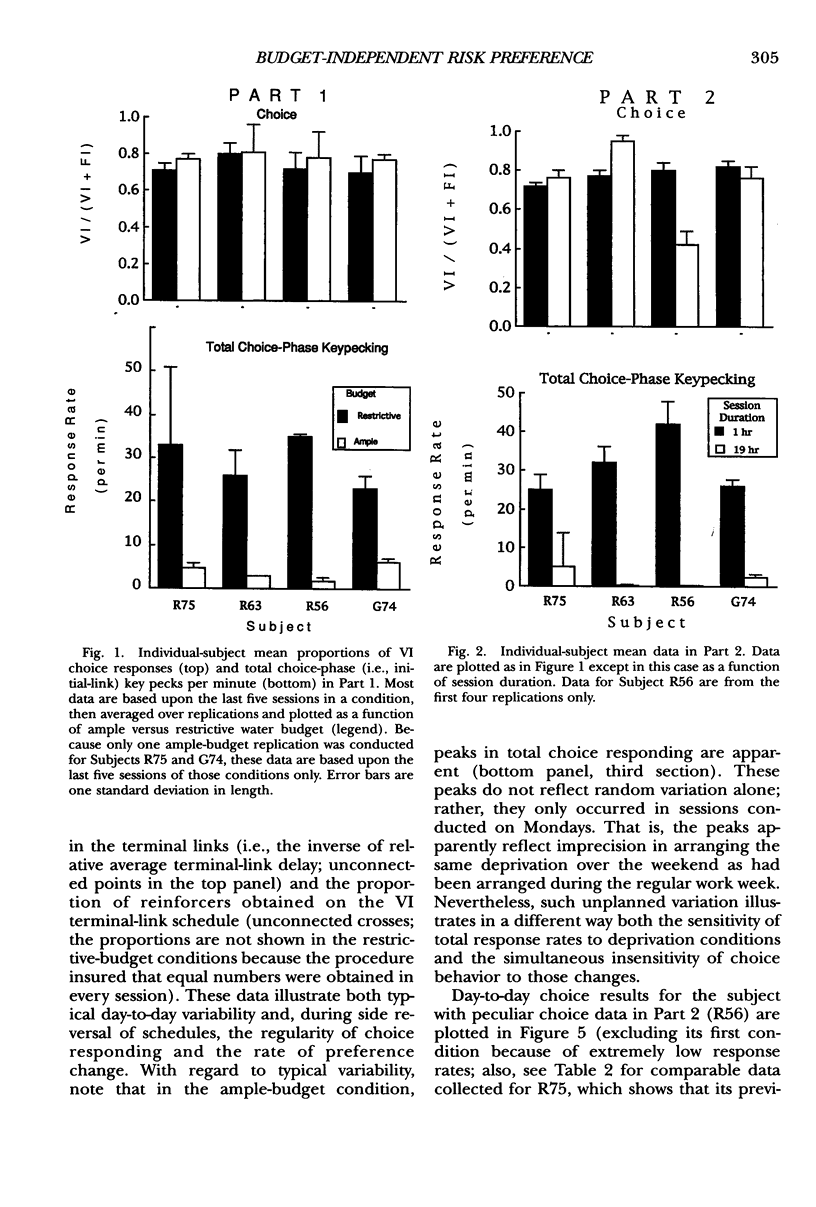
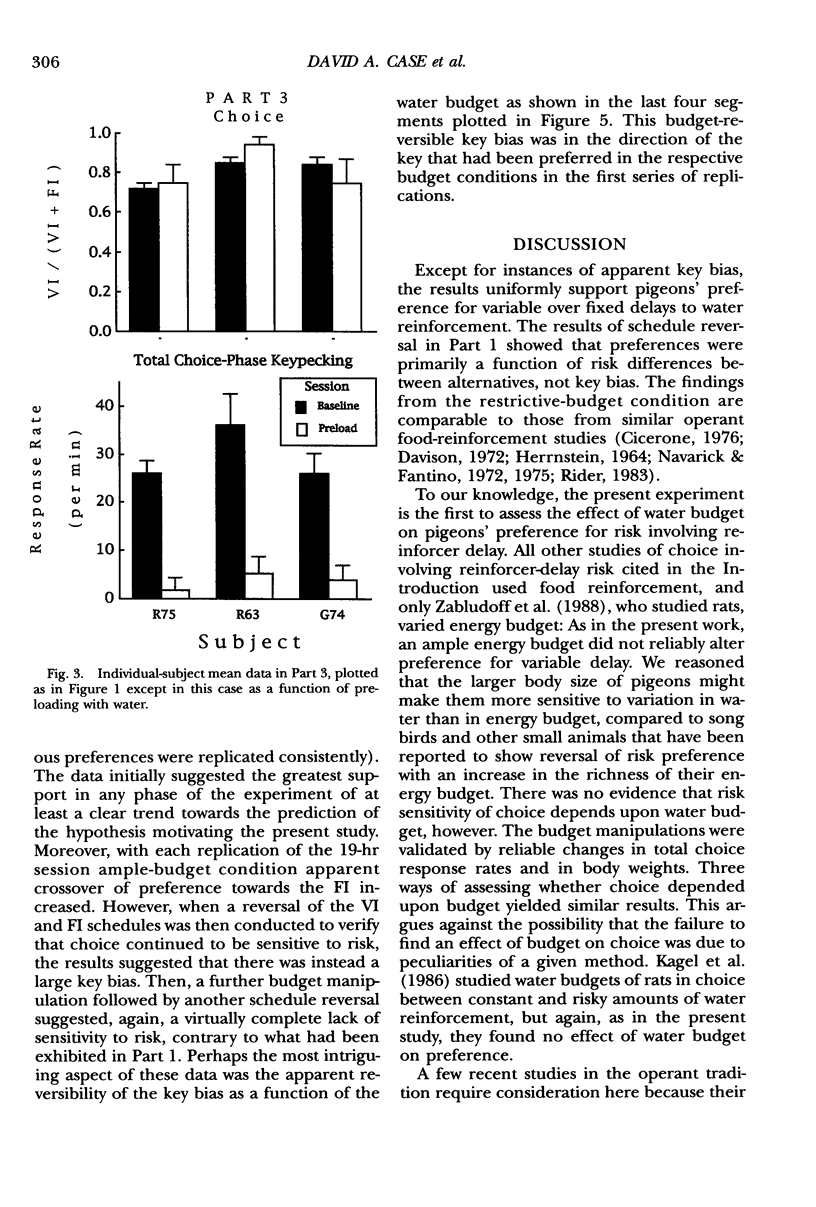
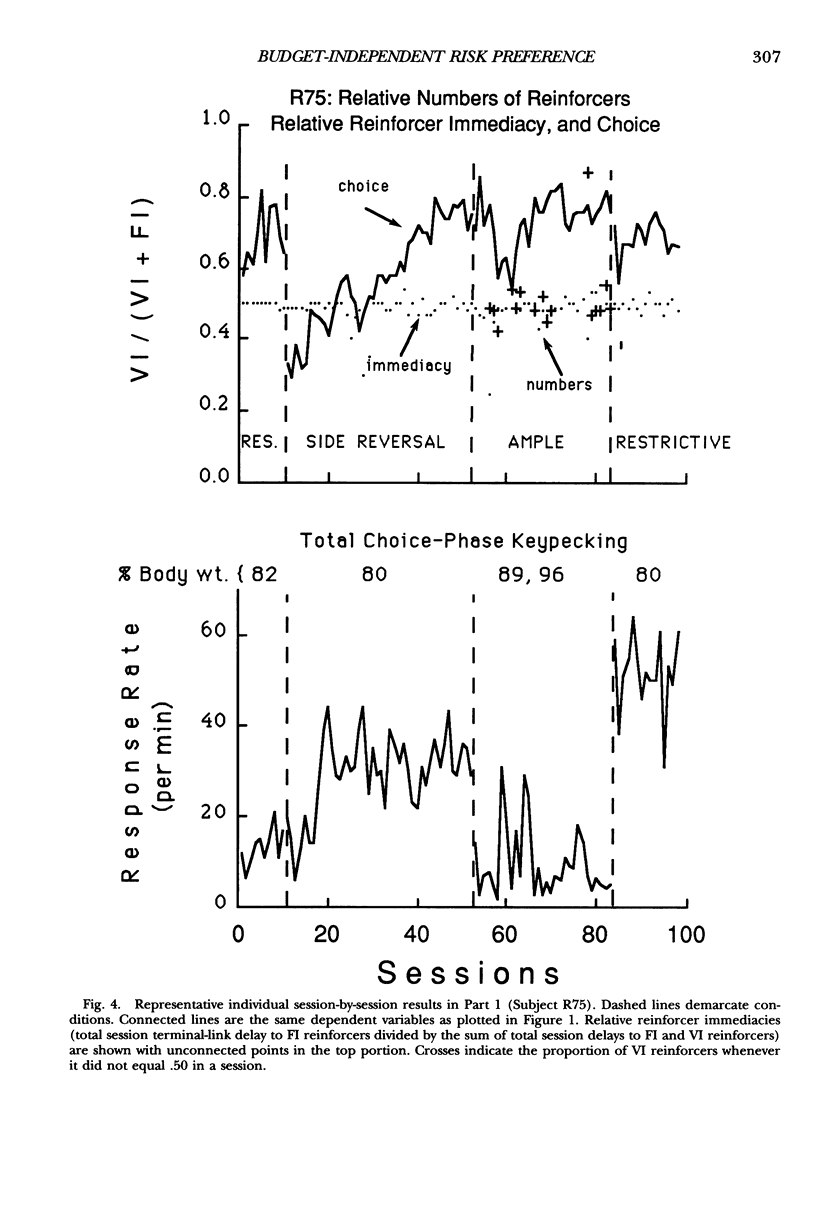
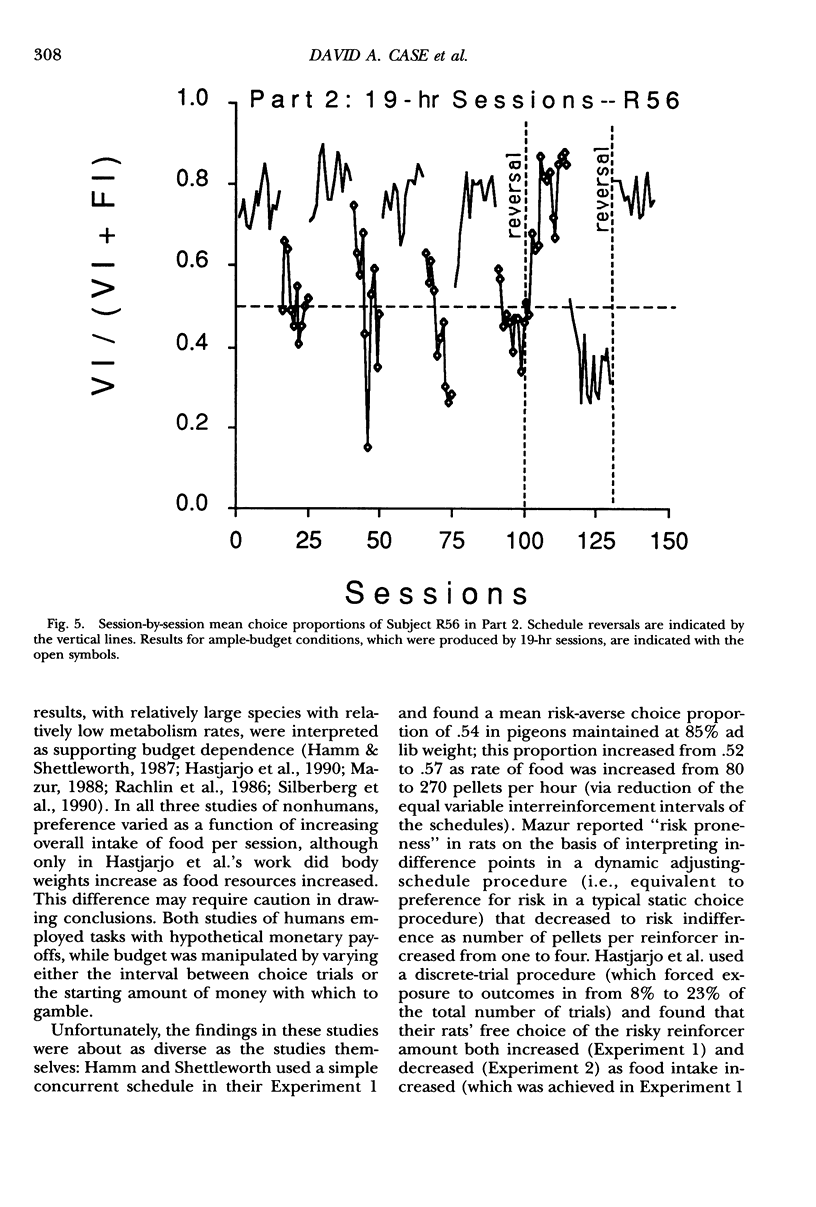
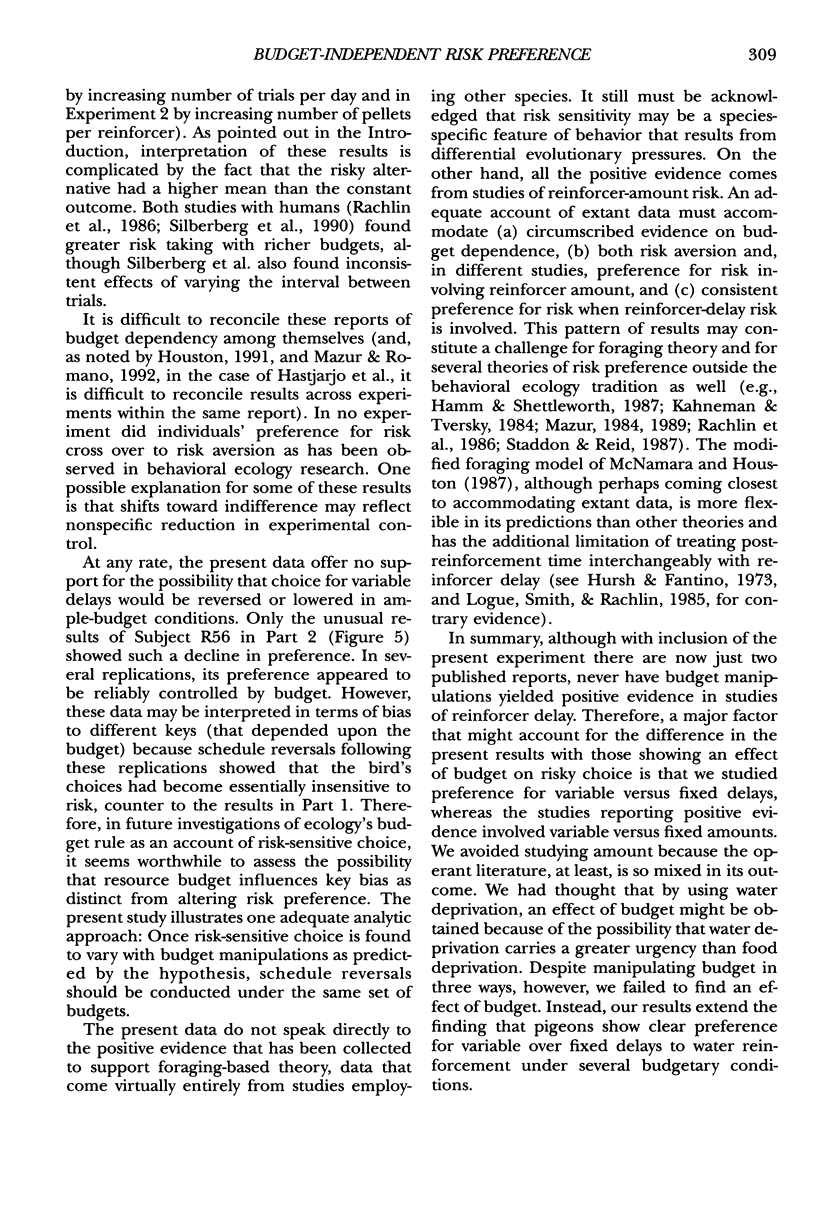
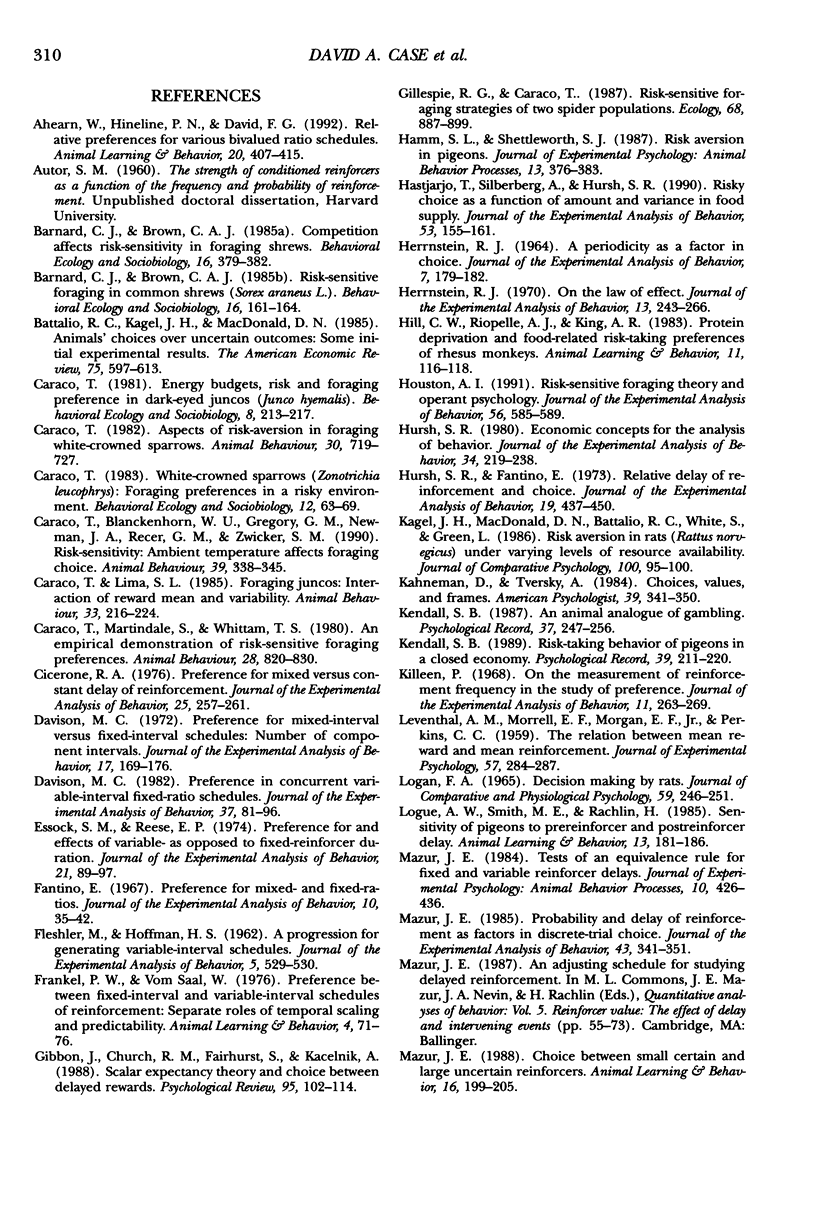
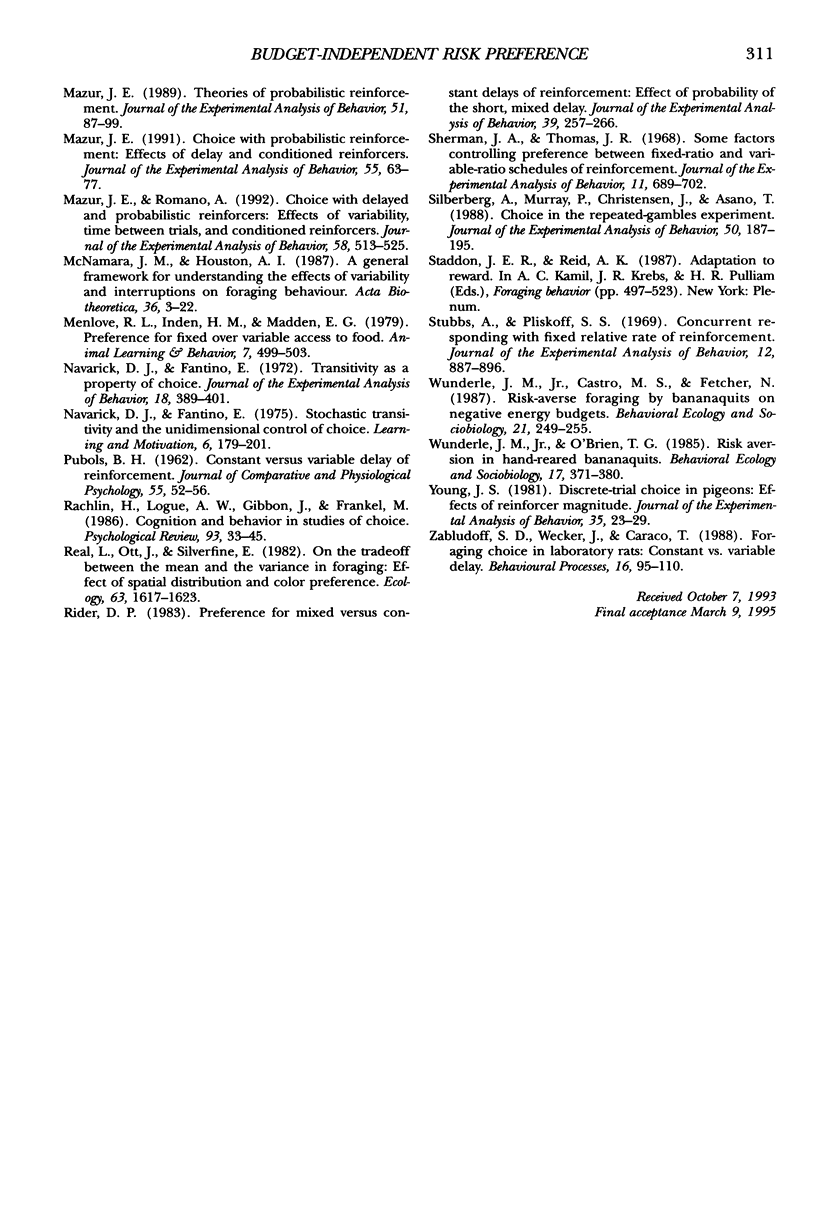
Selected References
These references are in PubMed. This may not be the complete list of references from this article.
- Cicerone R. A. Preference for mixed versus constant delay of reinforcement. J Exp Anal Behav. 1976 Mar;25(2):257–261. doi: 10.1901/jeab.1976.25-257. [DOI] [PMC free article] [PubMed] [Google Scholar]
- Davison M. C. Preference for mixed-interval versus fixed-interval schedules: number of component intervals. J Exp Anal Behav. 1972 Mar;17(2):169–176. doi: 10.1901/jeab.1972.17-169. [DOI] [PMC free article] [PubMed] [Google Scholar]
- Davison M. Preference in concurrent variable-interval fixed-ratio schedules. J Exp Anal Behav. 1982 Jan;37(1):81–96. doi: 10.1901/jeab.1982.37-81. [DOI] [PMC free article] [PubMed] [Google Scholar]
- Essock S. M., Reese E. P. Preference for and effects of variable-as opposed to fixed-reinforcer duration. J Exp Anal Behav. 1974 Jan;21(1):89–97. doi: 10.1901/jeab.1974.21-89. [DOI] [PMC free article] [PubMed] [Google Scholar]
- FLESHLER M., HOFFMAN H. S. A progression for generating variable-interval schedules. J Exp Anal Behav. 1962 Oct;5:529–530. doi: 10.1901/jeab.1962.5-529. [DOI] [PMC free article] [PubMed] [Google Scholar]
- Fantino E. Preference for mixed- versus fixed-ratio schedules. J Exp Anal Behav. 1967 Jan;10(1):35–43. doi: 10.1901/jeab.1967.10-35. [DOI] [PMC free article] [PubMed] [Google Scholar]
- Gibbon J., Church R. M., Fairhurst S., Kacelnik A. Scalar expectancy theory and choice between delayed rewards. Psychol Rev. 1988 Jan;95(1):102–114. doi: 10.1037/0033-295x.95.1.102. [DOI] [PubMed] [Google Scholar]
- HERRNSTEIN R. J. APERIODICITY AS A FACTOR IN CHOICE. J Exp Anal Behav. 1964 Mar;7:179–182. doi: 10.1901/jeab.1964.7-179. [DOI] [PMC free article] [PubMed] [Google Scholar]
- Hastjarjo T., Silberberg A., Hursh S. R. Risky choice as a function of amount and variance in food supply. J Exp Anal Behav. 1990 Jan;53(1):155–161. doi: 10.1901/jeab.1990.53-155. [DOI] [PMC free article] [PubMed] [Google Scholar]
- Herrnstein R. J. On the law of effect. J Exp Anal Behav. 1970 Mar;13(2):243–266. doi: 10.1901/jeab.1970.13-243. [DOI] [PMC free article] [PubMed] [Google Scholar]
- Houston A. I. Risk-sensitive foraging theory and operant psychology. J Exp Anal Behav. 1991 Nov;56(3):585–589. doi: 10.1901/jeab.1991.56-585. [DOI] [PMC free article] [PubMed] [Google Scholar]
- Hursh S. R. Economic concepts for the analysis of behavior. J Exp Anal Behav. 1980 Sep;34(2):219–238. doi: 10.1901/jeab.1980.34-219. [DOI] [PMC free article] [PubMed] [Google Scholar]
- Hursh S. R., Fantino E. Relative delay of reinforcement and choice. J Exp Anal Behav. 1973 May;19(3):437–450. doi: 10.1901/jeab.1973.19-437. [DOI] [PMC free article] [PubMed] [Google Scholar]
- Killeen P. On the measurement of reinforcement frequency in the study of preference. J Exp Anal Behav. 1968 May;11(3):263–269. doi: 10.1901/jeab.1968.11-263. [DOI] [PMC free article] [PubMed] [Google Scholar]
- LEVENTHAL A. M., MORRELL R. F., MORGAN E. F., Jr, PERKINS C. C., Jr The relation between mean reward and mean reinforcement. J Exp Psychol. 1959 May;57(5):284–287. doi: 10.1037/h0044878. [DOI] [PubMed] [Google Scholar]
- LOGAN F. A. DECISION MAKING BY RATS: UNCERTAIN OUTCOME CHOICES. J Comp Physiol Psychol. 1965 Apr;59:246–251. doi: 10.1037/h0021850. [DOI] [PubMed] [Google Scholar]
- Mazur J. E. Choice with probabilistic reinforcement: effects of delay and conditioned reinforcers. J Exp Anal Behav. 1991 Jan;55(1):63–77. doi: 10.1901/jeab.1991.55-63. [DOI] [PMC free article] [PubMed] [Google Scholar]
- Mazur J. E. Probability and delay of reinforcement as factors in discrete-trial choice. J Exp Anal Behav. 1985 May;43(3):341–351. doi: 10.1901/jeab.1985.43-341. [DOI] [PMC free article] [PubMed] [Google Scholar]
- Mazur J. E., Romano A. Choice with delayed and probabilistic reinforcers: effects of variability, time between trials, and conditioned reinforcers. J Exp Anal Behav. 1992 Nov;58(3):513–525. doi: 10.1901/jeab.1992.58-513. [DOI] [PMC free article] [PubMed] [Google Scholar]
- Mazur J. E. Theories of probabilistic reinforcement. J Exp Anal Behav. 1989 Jan;51(1):87–99. doi: 10.1901/jeab.1989.51-87. [DOI] [PMC free article] [PubMed] [Google Scholar]
- McNamara J. M., Houston A. I. A general framework for understanding the effects of variability and interruptions on foraging behaviour. Acta Biotheor. 1987;36(1):3–22. doi: 10.1007/BF00159228. [DOI] [PubMed] [Google Scholar]
- Navarick D. J., Fantino E. Transitivity as a property of choice. J Exp Anal Behav. 1972 Nov;18(3):389–401. doi: 10.1901/jeab.1972.18-389. [DOI] [PMC free article] [PubMed] [Google Scholar]
- PUBOLS B. H., Jr Constant versus variable delay of reinforcement. J Comp Physiol Psychol. 1962 Feb;55:52–56. doi: 10.1037/h0048566. [DOI] [PubMed] [Google Scholar]
- Rider D. P. Preference for mixed versus constant delays of reinforcement: Effect of probability of the short, mixed delay. J Exp Anal Behav. 1983 Mar;39(2):257–266. doi: 10.1901/jeab.1983.39-257. [DOI] [PMC free article] [PubMed] [Google Scholar]
- Sherman J. A., Thomas J. R. Some factors controlling preference between fixed-ratio and variable-ratio schedules of reinforcement. J Exp Anal Behav. 1968 Nov;11(6):689–702. doi: 10.1901/jeab.1968.11-689. [DOI] [PMC free article] [PubMed] [Google Scholar]
- Silberberg A., Murray P., Christensen J., Asano T. Choice in the repeated-gambles experiment. J Exp Anal Behav. 1988 Sep;50(2):187–195. doi: 10.1901/jeab.1988.50-187. [DOI] [PMC free article] [PubMed] [Google Scholar]
- Stubbs D. A., Pliskoff S. S. Concurrent responding with fixed relative rate of reinforcement. J Exp Anal Behav. 1969 Nov;12(6):887–895. doi: 10.1901/jeab.1969.12-887. [DOI] [PMC free article] [PubMed] [Google Scholar]
- Young J. S. Discrete-trial choice in pigeons: Effects of reinforcer magnitude. J Exp Anal Behav. 1981 Jan;35(1):23–29. doi: 10.1901/jeab.1981.35-23. [DOI] [PMC free article] [PubMed] [Google Scholar]


